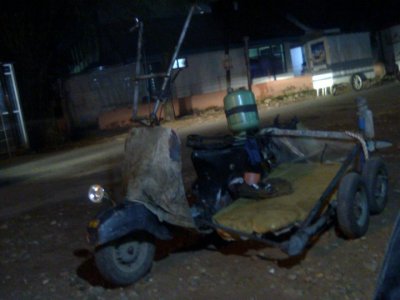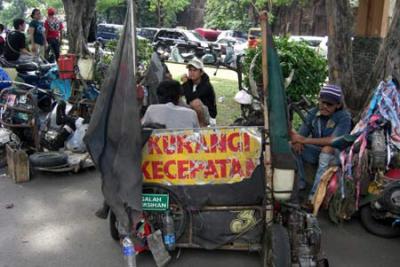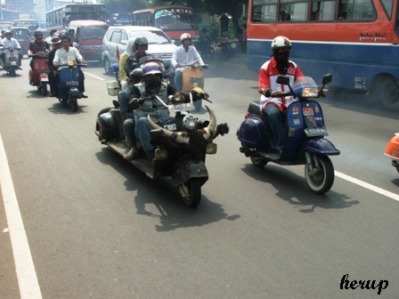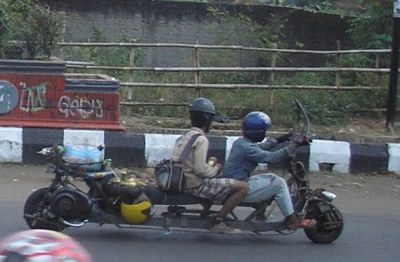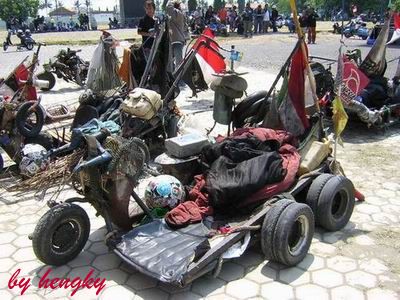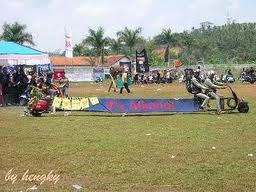First generation (1915–1930)
The Motoped entered production in 1915, and is believed to be the first motor scooter They were followed that year by the
Autoped, whose engine was engaged by pushing the handlebar column forward and whose brake was engaged by pulling the column back Autopeds were made in Long Island, New York
from 1915 to 1921,
and were also made under licence by
Krupp in Germany from 1919 to 1922.
The number of scooter manufacturers and designs increased after
World War I. The
Skootamota, the Kenilworth, and the Reynolds Runabout debuted in 1919, with
Gloucestershire Aircraft Company following with its Unibus in 1920. The Skootamota was noted for being practical, popular, and economical,
the Kenilworth for its electric lights
and the Reynolds Runabout for its advanced specifications, including
front suspension, a two-speed gearbox, leg shields, and a seat sprung
with leaf springs and coil springs. The Unibus also had a two-speed gearbox, but it is more notable for its
full bodywork, similar to that which would appear of second- and
third-generation scooters.
The reputation of first-generation scooters was damaged by a glut of unstable machines with flexible frames, and more substantial examples like the Reynolds Runabout and the Unibus were too expensive to be competitive.
The first generation had ended by the mid 1920s.
- First generation scooters, 1915–1930
-
-
-
Second generation (1936–1968)
E. Foster Salsbury and Austin Elmore developed the Salsbury Motor
Glide, a scooter with a seat above an enclosed drivetrain, and began
production in 1936 in California. In 1938, Salsbury introduced a more
powerful scooter with a
continuously variable transmission (CVT). This was the first use of a CVT on a scooter.
It was such a success that Salsbury attempted to license the design to
several European manufacturers including Piaggio. The Motor Glide set
the standards for all later models. It inspired production of motor
scooters by Powell, Moto-scoot, Cushman, Rock-Ola, and others.
The
Cushman Company produced motor scooters from 1936 to 1965.
Cushman was an engine manufacturer that started making scooters after
Salsbury found their offer to supply engines to be unacceptable. Cushman
and Salsbury competed against each other, with both companies
advertising the economy of their scooters. Cushman claimed an efficiency
of 120 mpg
-US (2.0 L/100 km; 140 mpg
-imp) at 30 mph (48 km/h). Cushman introduced a centrifugal clutch to their scooters in 1940.
The Cushman Auto Glide Model 53 was designed to be dropped by parachute
with Army Airborne troops, and was eventually called the “Cushman
Airborne”.
Cushman scooters were also used around military bases for messenger service.
Salsbury continued manufacturing scooters until 1948,
while Cushman continued until 1965.
Small numbers of the 165 cc (10.1 cu in)
Harley-Davidson Topper scooter were produced from 1960 to 1965 using the engine from
their line of light motorcycles based on the
DKW RT 125. It had a
fiberglass body, a
continuously-variable transmission, and a
pull-cord starting mechanism.
- Second generation scooters, USA, 1936–1965
-
Typical Cushman scooter, this one sold by
Sears under the
Allstate brand
-
1948 Salsbury Model 85 scooter, in the middle
-
Early postwar Japanese scooters
After World War II, wartime
aircraft
manufacturers were forbidden from making aircraft, and had to find
other products to make in order to stay in business. Fuji Sangyo, a part
of the former
Nakajima Aircraft Company, began production of the
Fuji Rabbit S-1 scooter in June 1946. Inspired by
Powell
scooters used by American servicemen, the S1 was designed to use
surplus military parts, including the tailwheel of a Nakajima bomber,
re-purposed as the front wheel of the S1.
Later that year,
Mitsubishi introduced the C10, the first of its line of
Silver Pigeon scooters.
This was inspired by a Salsbury Motor Glide that had been brought to
Japan by a Japanese man who had lived in the United States.
Production of the Mitsubishi Silver Pigeon and the Fuji Rabbit continued through several series until the 1960s.
Some series of the Fuji Rabbit were developed to a high level of
technological content; the S-601 Rabbit Superflow had an automatic
transmission with a torque converter, an electric starter, and pneumatic
suspension.
Mitsubishi ended scooter production with the C140 Silver Pigeon,
while Fuji continued production of the Rabbit until the last of the S-211 series was built in June 1968.
- Second generation scooters, Japan, 1946–1968
-
-
Fuji Rabbit Touring 150 (S-402)
Third generation (1946–1964) and beyond
Italy - Vespa and Lambretta
In post-World War II Italy the Piaggio
Vespa
became the standard for scooters, and has remained so for over 60
years. Patented in April 1946, it used aircraft design and materials.
D’Ascanio's 98 cc (6.0 cu in) scooter had various radical design
concepts, including a sleek, stress-bearing structure. The
gear shift lever was moved to the handlebars for easier riding. The engine was placed near the rear wheel, eliminating the
belt drive.
The typical fork support was replaced by an arm similar to an aircraft
carriage for easier tire-changing. The elegantly-styled body protected
the driver from wind and road dirt, and bore little resemblance to
uncomfortable and noisy motorcycles. The smaller wheels and shorter
wheelbase provide improved maneuverability through narrow streets and
congested traffic. Combining the best elements of automotive,
aeronautical and motorcycle design, the Vespa quickly became an icon of
design and economy. The name reportedly originated when Piaggio's
president upon seeing the prototype, remarked
"Sembra una vespa", "It looks like a wasp".
Months after the Vespa, in 1947, Innocenti introduced the
Lambretta,
beginning a rivalry with Vespa. The scooter was designed by Innocenti,
his General Director Giuseppe Lauro and engineer Pierluigi Torre. The
Lambretta was named after Lambrate, the Milanese neighborhood where the
factory stood.
It debuted in 1947 at the Paris Motor Show. The Lambretta 'A' went on
sale on December 23, 1947 and sold 9,000 units in one year. It was
efficient, at a time when petrol was severely rationed. It had a top
speed of 45 mph (72 km/h) from a fan-cooled engine of 123 cc
(7.5 cu in). The first Lambretta designs had shaft drive and no rear
suspension, later designs used various drive and suspension systems
until Lambretta settled on a swingarm-mounted engine with chain drive.
Germany
Germany's aviation industry was also dismantled after World War II.
Heinkel stayed in business by making bicycles and mopeds, while
Messerschmitt made sewing machines and automobile parts.
Messerschmitt took over the German licence to manufacture Vespa scooters from
Hoffman in 1954 and built Vespas under from 1954 to 1964.
Heinkel designed and built its own scooters. The
Heinkel Tourist
was a large and relatively heavy touring scooter produced in the 1960s.
It provided good weather protection with a full fairing, and the front
wheel turned under a fixed nose extension. It had effective
streamlining, perhaps thanks to its aircraft ancestry. Although it had
only a 175 cc (10.7 cu in)
4-stroke motor, it could sustain speeds of 70 mph (110 km/h). Heinkel scooters were known for their reliability.
[citation needed]
Glas, a
manufacturer of agricultural machinery, made the Goggo scooter from 1951
to 1955. Glas discontinued scooter production to concentrate on its
Goggomobil microcar.
Several manufacturers in the German motorcycle industry made scooters.
NSU
made Lambrettas under licence from 1950 to 1955, during which they
developed their Prima scooter. Production of the Prima began when NSU's
licence to build Lambrettas ran out.
Zündapp made the popular
Bella
scooter in the 1960s. It was in production for about ten years, in
three engine sizes, 150 cc (9.2 cu in), 175 cc (10.7 cu in) and 200 cc
(12 cu in). They could perform all day at a steady speed of 60 mph
(97 km/h). Extremely reliable and very well made, many of these scooters
still exist today.
Maico built the large
Maicoletta scooter in the 1950s. It had a single cylinder piston-port
two stroke engine,
with four foot-operated gears and centrifugal fan cooling. The
Maicoletta had a choice of engine sizes, approximately 175 cc
(10.7 cu in), 250 cc (15 cu in), or 275 cc (16.8 cu in), The tubular
frame was built on motorcycle principles, with long-travel telescopic
forks and 14-inch (356 mm) wheels. The Maicoletta had a top speed of
70 mph (110 km/h) which was comparable with most 250 cc (15 cu in)
motorcycles of the time. Other German scooters made by motorcycle
manufacturers included the
DKW Hobby, the Dürkopp Diana, and the
TWN Contessa.
[citation needed]
- Classic German scooters
-
Goggo scooter, made by
Glas
-
-
-
-
-
-



































.jpg)




